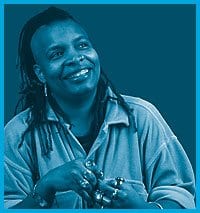Six pages was all it took to make Nalo Hopkinson a writer. A lifelong reader of science fiction, fantasy and speculative fiction, she signed up for a writing course at Ryerson University to be led by the venerable Canadian science fiction writer and anthologist Judith Merril. As a pre-requisite, Merril asked for a writing sample. Hopkinson, who had never written before, turned in six pages of what would later become her 1998 award-winning debut Brown Girl In The Ring, a dystopian novel set in Toronto and rich in Afro-Caribbean spirituality and language – a literary mixture that turned the still largely, white Eurocentric genre on its head.
Not surprisingly, Hopkinson was asked to join the class, only to have it cancelled because too few students were enrolled. Merril encouraged the students to proceed on their own and form a biweekly writers’ workshop. That’s where, in fits and starts, Hopkinson’s novel was born. She was 38 when it was published by Warner Books, after it won the Warner Aspect First Novel Contest.
“I think it took me that long to loosen my tongue,” Hopkinson says of mid-life career switch to writing. In the six years since, Hopkinson has published a short story collection (Skin Folk), edited two anthologies (Mojo: Conjure Stories and Whispers From The Cotton Tree Root) and written two more novels: Midnight Robber, which was nominated for the Hugo and Nebula awards, and, most recently, The Salt Roads, which came out in November – all this from someone who calls herself a “lazy” writer.
“I’d like to write every day, but I suffer from what I call ‘writer’s avoidance,'” Hopkinson says. “I hate routines, but I figure if I throw myself at the computer often enough, I’ll get something written. It seems to have worked.”
Born in Jamaica in 1960, Hopkinson lived in the Caribbean and briefly in the US before moving to Canada when she was a teenager. The daughter of an English teacher father and library technician mother, she grew up in a house full of books – her early favourites were Gulliver’s Travels and The Iliad – and in the Caribbean tradition of literary salons. “People would host salons in each other’s houses. There were a lot of poetry readings and plays presented in small theatres and school auditor-iums. That’s how the work got out.”
Her love of science fiction and fantasy literature came early. “I liked that the stories were different, [addressing] things that are supposed to be impossible, either because we don’t yet have the technology or because they’re supernatural. At the heart of the genre is the idea of personal and systemic change. That’s appealing and hopeful.
“And it’s a genre for misfits. It’s a genre in which it’s okay to be different. To be fat, or to be a goth or to be so smart that people find it difficult to understand you. I don’t know that we live in a world where anyone fits. I certainly don’t know anyone who says, ‘I’m fine. I fit in perfectly and look just like the pictures in all the fashion magazines.'”
Yet despite the enormous readership of science fiction and fantasy and the huge success of science fiction and fantasy films, Hopkinson says the genre is still not getting the respect it deserves.
“It’s still the kiss of death to have a book labelled science fiction. For instance, it took Margaret Atwood forever to say that she’s written science fiction. It remains a marginalized genre. Part of the problem is that the name is a misnomer, the shortest of the shorthands. It can’t possibly cover the range of speculative fiction, fantasy, utopian and dystopian fiction.
“The other issue is that Hollywood films in the genre don’t tend to be that good. They’re superficial. They don’t wrestle ideas of human existence the way good science fiction does. There are exceptions, like Minority Report, but, then, that was based on a story by Philip K Dick.”
The Salt Roads employs Hopkinson’s trademark melding of science fiction conventions with Afro-Caribbean mythology. The novel interweaves the story of three black women: Jeanne Duval, the mistress of 19th-century French poet Charles Baudelaire; Meritet, the Nubian prostitute who becomes St Mary Of Egypt after her AD 300 pilgrimage to Jerusalem; and Mer, a slave and community doctor, in 18th-century Haiti (then called St Domingue). Connecting the three is the spirit of Ezili, the Afro-Caribbean goddess who inhabits each of them during their lives. With vivid period detail and a gripping narrative, the novel powerfully examines the brutal circumstances of the characters’ lives and imbues them with a sense of joy and hope – and, unexpectedly, humour.
The book is also a conscious nod to the history of science fiction writing, of which Hopkinson is an enthusiastic expert. Baudelaire was born around the time Mary Shelley’s Frankenstein was published. Some considered it the first real science fiction novel, Hopkinson points out, “and one that no one at the time believed could have been written by a woman.” She also includes mention of Baudelaire’s translations of Edgar Allan Poe’s work, as well as the poet’s encounters with a young Jules Verne.
“During that period in France, there was a huge interest in mesmerism and ballooning, both of which fuelled the early science fiction writing,” Hopkinson says. “Ballooning, of course, made its way into Verne’s books [Five Weeks In A Balloon and Around The World In 80 Days].”
Sex and sexuality also play a large role in the book. In ancient Alexandria, Meritet services several customers a day and talks frankly about sex and birth control with other prostitutes. Mer finds comfort in the arms of her married female lover Tipingee. And Jeanne has sex with her friend Lise, when she’s not occupied with Baudelaire.
Hopkinson says her frankness has earned her some critics. “But my response is to ask, ‘So, if it turns you on, then it isn’t good literature?’ That just doesn’t make sense.
“One of my favourite writers is Samuel R Delany. I love how he normalizes sexual practices that are so out there. Because if you were able to sit the average person down and ask them what they like to do in bed, you’d realize that everyone is kind of out there.
“As for how explicit the [The Salt Roads] is, well, I’m not good with euphemisms, and as an image maker, I don’t like to be coy. The women in the novel aren’t the kind to traffic in niceties. What helped me a lot in writing was The Big Book Of Filth, which was a lexicon of sexual language throughout history by class, time period and geographic location. I could look up the language that the women would have used. It was so much fun.”
As for her own sexuality, Hopkinson jokingly refers to herself as “ambiguously everything.”
“My life partner is a man. I’d define myself as queer for gender queers. That’s a fairly recent self-definition. As a feminist and a writer, I attack rigid notions of gender. I queer things in my work. A lot of science fiction writing does that. I like writing about people you don’t see in literature, characters who are unexpected. I’d definitely say that I’m a queer writer.
“I was at a Meshell Ndegeocello concert once in Toronto. Half the crowd was uptown, urban, black heterosexuals. The other half were downtown white dykes. They were looking at each other like, ‘Who are you?’ and ‘What are you doing here?’ And I looked at both those groups and thought, ‘Well, I don’t know who I am, but I really like Meshell’s stuff.
“I think that sums up my identity and my audience. People who are drawn to my work come from all different backgrounds. There’s the science fiction people, the queers, the people from the Caribbean, women. They all just like my stuff.”
THE SALT ROADS.
Nalo Hopkinson.
Warner Books. $34.


 Why you can trust Xtra
Why you can trust Xtra


